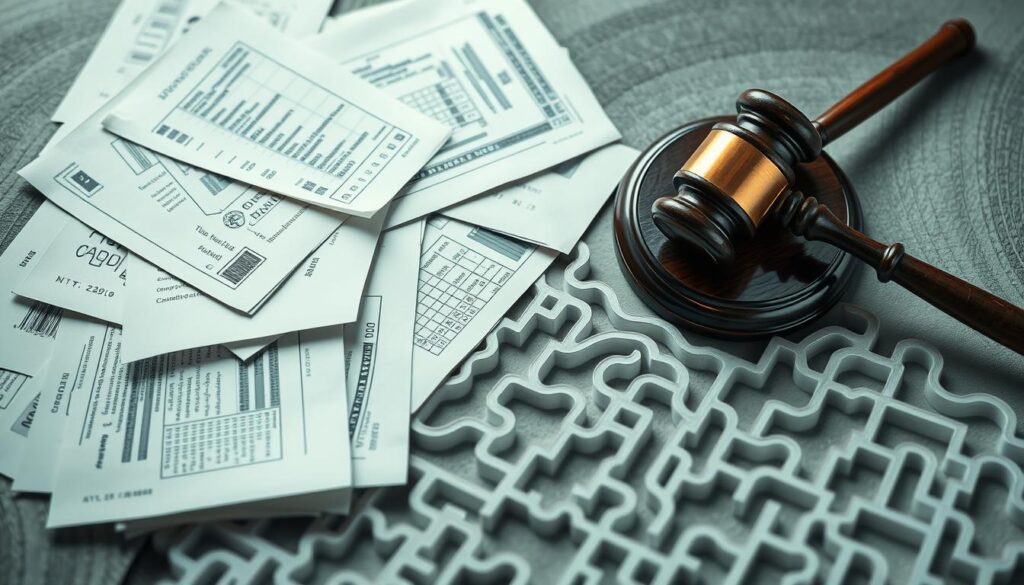A strong credit profile is vital for financial stability. Credit reports may contain errors that hurt your creditworthiness. The Fair Credit Reporting Act (FCRA) lets you dispute and fix wrong information on your credit reports.
The FCRA 609 dispute letter is a powerful tool for this purpose. It helps you challenge inaccuracies and improve your credit score.
This guide explains the FCRA and your consumer rights. You’ll learn how to write an effective 609 letter and deal with credit bureaus. We’ll also cover debt validation and credit disputes.
Key Takeaways
- The Fair Credit Reporting Act (FCRA) protects consumer rights and allows for the correction of inaccurate information on credit reports.
- A FCRA 609 dispute letter is a powerful tool to challenge and remove erroneous data from your credit profile.
- Understanding the key components of a 609 letter and the steps to write an effective one is crucial for successful credit repair.
- Proper handling of credit disputes and debt validation can lead to the removal of negative items from your credit report.
- Avoiding common mistakes and following best practices when sending a 609 letter can maximize your chances of success.
Understanding the Fair Credit Reporting Act
The Fair Credit Reporting Act (FCRA) governs consumer credit information handling. It gives consumers rights to dispute and correct inaccurate credit report data. This federal law ensures fair and accurate credit reporting.
What is the Fair Credit Reporting Act?
The FCRA, enacted in 1970, promotes accurate and private consumer credit reports. It sets rules for credit agencies and lenders handling personal credit data.
This law empowers consumers to access their credit reports. It allows them to challenge wrong information and hold credit bureaus accountable.
Consumer Rights Under the FCRA
The Fair Credit Reporting Act grants consumers several key rights:
- The right to obtain a free copy of their credit report annually from each of the three major credit bureaus (Experian, Equifax, and TransUnion).
- The right to dispute any inaccurate or incomplete information on their credit report and have it corrected or removed.
- The right to be informed when information in their credit report has been used against them, such as in the denial of credit or employment.
- The right to have outdated negative information removed from their credit report after a certain period of time.
- The right to have their credit report kept confidential and only accessed for legitimate business purposes.
Knowing FCRA rights helps consumers maintain accurate credit reports. This knowledge is vital in today’s financial world.
The Importance of a 609 Dispute Letter
A 609 dispute letter is a powerful tool for challenging negative items on credit reports. It’s named after a section of the Fair Credit Reporting Act (FCRA). This letter can help improve your credit score and financial health.
The 609 dispute letter is crucial for credit disputes. It allows you to address errors or questionable information in your credit report. By using this letter, you can make credit bureaus investigate and possibly remove negative items.
“Successful credit dispute letters can lead to the removal of negative items, a higher credit score, and improved financial opportunities.”
A 609 dispute letter can tackle various credit report issues. These include inaccurate information, fraudulent accounts, and outdated negative items. It can also address errors in reporting payments or balances.
- Inaccurate or unverifiable information
- Fraudulent accounts or identity theft
- Outdated or obsolete negative items
- Erroneous reporting of payments or balances
Understanding the 609 dispute process is key to success. Crafting a well-structured letter improves your chances of removing negative items. This can boost your credit score and open up better financial opportunities.

| Benefit | Description |
|---|---|
| Improved Credit Score | Successful 609 dispute letters can lead to the removal of negative items, resulting in a higher credit score. |
| Better Financial Opportunities | With a higher credit score, you may qualify for lower interest rates, better loan terms, and more favorable financial products. |
| Greater Financial Well-being | Addressing and resolving credit report issues can provide peace of mind and improve your overall financial situation. |
fair credit reporting act 609 letter
The FCRA 609 dispute letter helps you challenge wrong info on your credit reports. It’s based on Section 609 of the Fair Credit Reporting Act. This letter outlines key parts for a successful credit dispute.
Key Components of a 609 Dispute Letter
Your 609 dispute letter needs specific details about the 609 dispute letter, credit disputes, and debt validation. Clearly point out wrong info and ask credit bureaus to investigate and remove it.
Include the account number, creditor name, and what’s wrong. Explain why it’s incorrect and provide proof. Ask the credit bureau to look into it and remove the wrong info.
Attach a copy of your credit report. Mark the disputed items clearly. Ask for the results and a free credit report after resolving the dispute.
- Identify the specific item(s) you are disputing on your credit report, including the account number, creditor name, and the nature of the inaccuracy.
- Explain why the information is inaccurate and provide any supporting documentation or evidence you have.
- Formally request that the credit bureau(s) investigate the dispute and remove the inaccurate information from your credit report.
- Include a copy of your credit report with the disputed items clearly marked.
- Request a copy of the credit bureau’s reinvestigation results and a free credit report once the dispute is resolved.
A good 609 dispute letter boosts your chances of fixing credit report errors. It helps you use your rights under the FCRA.
“A well-crafted 609 dispute letter can be a game-changer in resolving inaccuracies on your credit report.”
The FCRA gives you the right to dispute wrong credit report info. A 609 letter is a strong tool for this. Use it to take charge of your credit and build a better financial future.
Credit Bureaus and Their Role
Credit bureaus play a vital role in managing consumer credit information. Experian, Equifax, and TransUnion are the three major credit bureaus in the United States. They collect and maintain data used to assess creditworthiness.
Lenders, employers, and other entities rely on this information for decision-making. Understanding credit bureaus is crucial for navigating credit reports and disputes effectively.
The Three Major Credit Bureaus
Each credit bureau has a unique role in the credit reporting ecosystem:
- Experian is one of the largest credit bureaus, providing comprehensive credit reports and credit scores to lenders and consumers.
- Equifax is another leading credit bureau that collects and analyzes consumer credit data, offering credit monitoring and identity protection services.
- TransUnion is the third major credit bureau, known for its innovative credit-related products and services, including credit reports and credit scores.
Credit bureaus gather information from various sources to create individual consumer credit reports. These sources include lenders, creditors, and public records.
Knowing how credit bureaus work helps consumers protect their rights. It also enables them to dispute any errors in their credit reports effectively.
| Credit Bureau | Key Services | Contact Information |
|---|---|---|
| Experian | Credit reports, credit scores, credit monitoring | Phone: 1-888-397-3742 Website: www.experian.com |
| Equifax | Credit reports, credit scores, identity protection | Phone: 1-800-685-1111 Website: www.equifax.com |
| TransUnion | Credit reports, credit scores, credit-related products | Phone: 1-800-888-4213 Website: www.transunion.com |

“Understanding the role of the credit bureaus is essential for effectively navigating the credit dispute process.”
Debt Validation and Credit Disputes
The Fair Credit Reporting Act (FCRA) 609 dispute letter helps consumers validate debts and resolve credit disputes. Debt validation checks if a debt is accurate and legitimate. It ensures your credit report information is correct.
The 609 letter is a useful tool for debt validation. You can ask credit bureaus to verify a debt by sending this letter. If proof isn’t provided, they must remove the item from your report.
The 609 letter also helps dispute inaccurate or unverifiable items on your credit report. This includes wrong account info, false late payments, or debts that aren’t yours. Using this letter can improve your score and protect your consumer rights.
Debt validation and credit disputes can be tricky. But knowing your FCRA rights and using the 609 letter can help fix credit report issues. Taking action ensures your credit info is accurate.
This proactive approach can improve your financial future. It helps maintain a healthy credit profile.
Steps to Write an Effective 609 Letter
A 609 dispute letter helps fix errors on your credit report. You’ll need details about the wrong item. This includes the account number, creditor name, and error specifics.
Your letter will ask credit bureaus to investigate and remove the item. It’s important to be persuasive in your writing.
Gathering Necessary Information
First, review your credit report to find the item you want to dispute. Collect these details:
- Account number associated with the inaccurate item
- Name of the creditor or entity reporting the item
- Detailed description of the error or inaccuracy
- Any supporting documentation or evidence you have to substantiate your claim
Drafting the Letter
Now, start writing your 609 dispute letter. Here are tips for an effective letter:
- Begin with a clear statement about the inaccurate item you’re disputing.
- Explain the error in detail. Include account info and evidence.
- Ask the credit bureau to investigate and remove the item if it’s wrong.
- Include a copy of your credit report. Highlight the disputed item.
- End by restating your request and expecting a quick response.
These steps will help you write a strong 609 dispute letter. It can address credit disputes and credit repair issues effectively.

Credit Repair and Debt Removal
The 609 dispute letter is a potent tool for credit repair and debt removal. It helps remove inaccurate information from your credit report. This can significantly improve your credit score and financial health.
Credit disputes challenge incorrect or unverifiable items on your credit report. Removing negative items can boost your credit score. Better credit scores lead to lower interest rates on loans and credit cards.
Debt removal aims to reduce or eliminate outstanding debts. Strategies include debt consolidation and negotiation with creditors. Managing and reducing debt improves your overall financial well-being.
The 609 dispute letter helps challenge inaccurate information on your credit report. It uses Fair Credit Reporting Act provisions to improve your credit profile. This tool gives you control over your financial future.
“Credit repair and debt removal are not just luxuries, but essential steps towards financial freedom and security.”
Combining the 609 dispute letter with other strategies can greatly improve your finances. This approach helps you achieve your long-term financial goals. It paves the way for a more secure financial future.
Consumer Rights and Section 609
Disputing wrong info on your credit report is essential. Section 609 of the Fair Credit Reporting Act (FCRA) outlines your rights. It helps you challenge and fix errors in your credit file.
Understanding Section 609
Section 609 lets you request your credit report and dispute any mistakes. It holds credit bureaus accountable for accurate records. This law helps protect your credit and financial health.
Section 609 gives you important rights. You can get a free yearly credit report from Experian, Equifax, and TransUnion. You can dispute errors and have them fixed.
Credit bureaus must respond to disputes quickly. If unsatisfied, you can add a statement to your file. These rights help maintain accurate credit reports.
- The right to obtain a free copy of your credit report annually from each of the three major credit bureaus: Experian, Equifax, and TransUnion.
- The ability to dispute any errors or inaccuracies on your credit report and have them investigated and corrected by the credit bureaus.
- The requirement for credit bureaus to respond to your dispute within a reasonable timeframe and provide you with the results of their investigation.
- The option to include a statement of dispute in your credit file if the credit bureau does not resolve the issue to your satisfaction.
Using Section 609 helps keep your credit report accurate. This can lead to better credit terms and loan access. It also opens up more financial opportunities.
“Empowering consumers to take control of their credit records is the foundation of the Fair Credit Reporting Act’s Section 609.”
Best Practices for Sending a 609 Letter
A 609 dispute letter is key to exercising your rights under the Fair Credit Reporting Act. Following best practices when sending your letter can lead to better outcomes.
These steps will help protect your consumer rights and address credit disputes effectively. Let’s explore some essential tips for crafting your 609 letter.
- Utilize Certified Mail: Send your 609 letter via certified mail with a return receipt. This provides proof of delivery and creates a paper trail for future reference.
- Keep Detailed Records: Save copies of all communications with credit bureaus. This includes your 609 letter, responses, and any actions taken afterward.
- Follow Up Promptly: Be proactive in following up with credit bureaus after sending your letter. They must respond within 30 days, so check in if you don’t hear back.
- Leverage Consumer Rights: Know your FCRA rights, like requesting free credit reports and disputing inaccuracies. This knowledge strengthens your position when dealing with credit bureaus.
These practices boost your chances of success when sending a 609 dispute letter. They help protect your credit disputes and consumer rights effectively.
“The 609 dispute letter is a powerful tool for consumers to challenge inaccuracies on their credit reports and reclaim their financial freedom.”
Maximizing the Effectiveness of Your 609 Letter
To make your 609 dispute letter even more effective, try these additional tips:
- Attach Relevant Documentation: Include copies of supporting documents like payment records or bankruptcy filings. This strengthens your case significantly.
- Specify the Desired Outcome: Clearly state what actions you want the credit bureaus to take. This might include removing disputed items or fixing incorrect information.
- Remain Persistent: If credit bureaus don’t respond or resolve the issue, follow up. Consider escalating to regulatory authorities if needed.
These practices help you address 609 dispute letter issues through the FCRA’s process. They increase your chances of successfully resolving credit disputes.
Remember, knowing your consumer rights is crucial. It empowers you to tackle credit report inaccuracies with confidence.
Common Mistakes to Avoid
Credit disputes and credit repair require careful attention to detail. Avoiding common mistakes can protect your consumer rights. Let’s focus on two significant pitfalls: inaccurate information and missed deadlines.
Inaccurate Information
Incorrect details in your 609 dispute letter can delay or derail your claim. Double-check all information, including personal details and disputed items. Accuracy is vital for a successful credit dispute.
Missed Deadlines
The Fair Credit Reporting Act (FCRA) sets timelines for credit bureaus to investigate disputes. Missing these deadlines can lead to dismissal of your claim. Stay proactive and follow up with credit bureaus promptly.
| Common Mistake | Impact | How to Avoid |
|---|---|---|
| Inaccurate Information | Delays or rejection of your dispute | Double-check all personal details and disputed items |
| Missed Deadlines | Dismissal of your dispute | Stay on top of FCRA-mandated timelines and follow up promptly |
Avoiding these pitfalls can boost your chances of resolving credit disputes successfully. By following best practices, you’ll protect your consumer rights. This approach supports effective credit repair and credit disputes.

Success Stories and Testimonials
The Fair Credit Reporting Act (FCRA) 609 dispute letter helps many fix their credit and remove debts. It empowers people to take charge of their financial futures. Let’s look at some inspiring stories from those who’ve used this tool.
Sarah, a young professional, battled identity theft aftermath. “Unauthorized accounts on my credit report lowered my score,” she says. “The 609 letter helped remove those fraudulent items. My credit score improved significantly.”
“The 609 letter gave me the power to assert my consumer rights and take back control of my financial standing.
John, a small business owner, faced credit report inaccuracies. These errors made it hard to get financing. “I used the 609 letter steps,” he explains. “In a few months, credit bureaus removed the wrong information.”
This boost in John’s credit score helped him secure funding. He was then able to expand his business. These stories show how powerful the FCRA 609 dispute letter can be.
The letter helps people challenge credit report errors and fraud. It upholds consumers’ rights and paves the way for better financial health. These credit repair and debt removal successes prove its effectiveness.
Conclusion
The Fair Credit Reporting Act 609 letter is a powerful tool for fixing credit report errors. It helps you take control of your financial health. By using this tool, you can work towards a clean credit history.
The 609 dispute letter is key in credit repair. It allows you to challenge wrong information in your credit file. This letter can help with identity theft, reporting errors, and old debts.
Keep an eye on your credit report regularly. This habit is crucial for your financial success. Stay informed and take action to protect your credit score.
By being proactive, you can get better lending terms. This paves the way for a brighter financial future. Remember, your credit health is in your hands.

